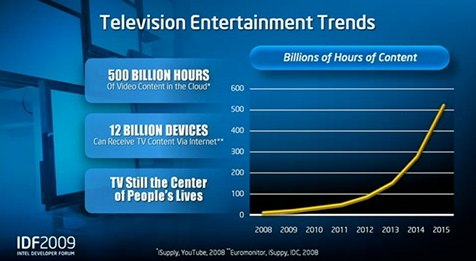3D football, anyone? Intel offers peek at 21st Century television

TV isn't TV anymore. It's out of the box. It's off the wall and it's not going back anytime soon.
That was the opening line of the final keynote at the Intel Developer Forum, delivered by Intel exec Justin Rattner, who took to the stage to talk about the future of TV. At last year's IDF, Yahoo and Intel sparked some interest with their demos of Widget TV, which will bring an app-like experience to the living room screen. This year, the focus was around a couple of other topics, including multiple devices, customization, social interaction and the coming of 3D viewing.
It's pretty much a given that a 21st Century television experience is on the horizon. Rattner pointed out some stats: by 2015, expect to see 500 billion hours of video content on the cloud and 12 billion devices capable of receiving "TV" content via the Internet. The devices part is important to remember, especially as it relates back to the continuum that Intel CEO Paul Otellini referenced in the opening keynote earlier this week.
The idea is that the video viewing experience should be the same whether you're watching on a TV, laptop, iPhone or some other sort of mobile Internet device, or MID. Developers and content creators shouldn't have to worry about the platform, Otellini said. The technology should allow the content to recognize the platform and adjust accordingly. But Intel has visions of taking the interaction between TV and mobile devices a step further.
One of the on-stage demos involved Rattner, carrying an MID, walking toward a television screen with a set-top box connected. As he physically got closer to the TV, the set-top box recognized the MID and the content on it. So it knew from his calendar, for example, that he had dinner plans in an hour - so it knew not to offer a long movie or a sporting event. It also knew that he had been researching guitars on his MID and taken it with him into a Guitar Center store over the weekend. Yup, there were guitar ads on the TV screen for him.
Rattner also talked about how Intel researchers have long studied human interaction with computers. It's not just what they do but how they do it that gives Intel the information it needs to build its next generation of products. Studying the habits of TV viewers also offers some insight. The company showed a video about what researchers at Georgia Tech University are doing to study human interaction with television. One line from that video stuck with me: "People Tivo, Hulu, and YouTube interchangeably while they IM, text, tweet and blog."
Yup. They do.
For generations, people have been socially interacting with what they experience on TV. (Any Trekkies out there?) The researchers are trying to understand and design new social media experiences around the media. Sure, that could be as simple as Facebook and Twitter type stuff - or other online forums for people to engage in discussions about what they've just seen and experienced via the TV show. Imagine, for example, that a viewer can now experience the show in a virtual world or maybe have that experience show up in an iPhone game.
Bringing it together, Intel took a moment to remind us that all of these plaforms, all of these experiences and interactions are being built on the Intel architecture, which keeps getting faster and more refined. The company today unveiled the Atom CE4100, formerly known as Sodaville, the first 45nm consumer electronics System-on-Chip, designed to Web content and services to devices such as digital TVs, DVD players and advanced set-top boxes. But it isn't just processor technology that will drive the future of TV. It's the developers that will shape 21st Century build on the architecture to offer new experiences and interactions that will shape the future.
Stuff like 3D.
That technology is also in the works. Companies like Sony and Panasonic are talking about 3D sets, Rattner said. But Intel invited smaller companies on stage to talk about what they're doing, as well. A company called HDI, for example, is creating a technology for scanning frames at a rate that produces 3D images using laser technology.
But another company, called 3ality Digital, is taking the technology beyond recorded movies. They're focusing on the ability to bring 3D technology to live television. The demos showed some interesting possibilities that could be eventually tied to what Cisco is doing with telepresence (think a meeting room with 3D images of colleagues scattered around the globe.) But what's even bigger than that? Why, sports, of course.
I can see the possibilities now: big linebackers crushing through the living room, throwing each other into the sofa and falling on top of the drinks and snacks - all without breaking or spilling anything.
If that's not a good reason for talking the wife into a new TV, I don't know what is.
Previous IDF coverage:
- Intel's Maloney: Enhanced technology can address demands of new data center
- Intel on laptop chips: Speed kills
- Intel to developers - write apps for Atom
- Intel’s Moblin demo looks promising
- IDF: 09: A look at smart signs and digital slot machines
- Intel: 32nm is just the beginning
- Intel teases 22 nanometer chips